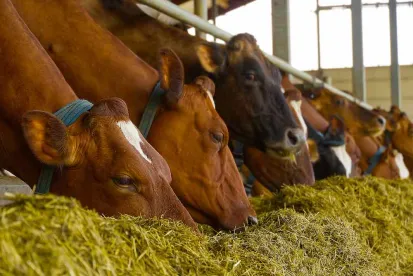On March 7, 2022, the US Food and Drug Administration (FDA), operating under its New Animal Drug Authority, took a new, important regulatory step forward in assessing genome editing in animals. Specifically, the Agency announced a “low risk” determination and exercise of enforcement discretion over an intentional genomic alteration (“IGA”) that produced a slick-hair coat in cattle intended for food use. As part of its low-risk determination, FDA found that the IGA in the cattle results in the equivalent genotype (genetic make-up) and short-hair coat trait seen in some conventionally-bred cattle and pose “low risk to people, animal, the food supply, and the environment,” and that it “will not object” to the cattle or products derived from them being introduced or marketed without premarket approval under the Federal Food, Drug, and Cosmetic Act (FDCA).
FDA defines IGAs as alterations made using molecular technologies that introduce changes to an animal’s genome. The IGA in these cattle are referred to as PRLR-SLICK— a naturally-occurring mutation that results in an extremely short, slick-hair coat. The scientific literature has indicated that slick-coat cattle may be better able to withstand hot weather, more comfortable in their environment, and less likely to experience temperature-related stress, which could result in improved food production.
In making this low-risk determination, FDA reviewed information submitted by the product developer, which confirmed that (i) the IGA in PRLR-SLICK cattle is equivalent to naturally-occurring mutations that have arisen in conventionally-bred cattle as an adaptation to being raised in tropical environments; (ii) food from PRLR-SLICK cattle is as safe as food from as conventionally bred cattle with the same slick-hair trait, and (iii) the IGA results in the same slick-hair trait as in conventionally-raised cattle.
FDA’s Center for Veterinary Medicine’s (“CVM”) oversight of IGAs in animals under the FDCA includes a risk-based evaluation with a particular focus on safety. For IGAs in animals that are food-producing, CVM had previously said that it may exercise enforcement discretion on a case-by-case basis if, after a risk-based review, it determines that a product or category of products is low risk to humans, animals, and the environment.
As a result of the FDA’s low-risk determination for enforcement discretion here, the developer need not seek FDA approval of a New Animal Drug Application before commercialization. The FDA has also said in prior guidance that it will not undertake a National Environmental Policy Act review for products for which it exercises enforcement discretion.
According to the FDA press release, the developer, which specializes in precision breeding, plans to use the genetic products from these animals with select customers in the global market soon and anticipates that meat products will be available for consumer purchase in the coming two years. The United States Department of Agriculture exercises inspection and food safety authority over meat products sold in interstate commerce pursuant to the Federal Meat Inspection Act.
While this is the first “low risk” determination for food-use animals containing an IGA, the Agency has exercised enforcement discretion based on low-risk determinations for other IGAs in animals for non-food uses and has also approved applications for IGAs in pigs, rabbit, goat, chicken, and salmon.





 />i
/>i
